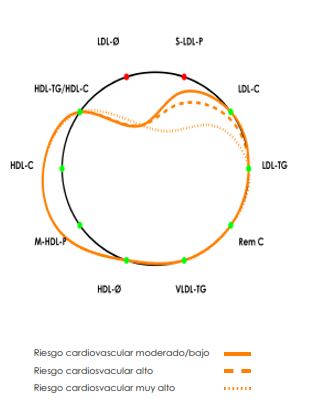
Liposcale®
Advanced Lipoprotein Test
The Liposcale® Test is an advanced lipoprotein test based on Nuclear Magnetic Resonance (NMR), which directly measures the normal lipid profile, in addition to the particle number and size, the cholesterol and triglyceride composition of the main lipoprotein classes and subclasses (VLDL, LDL, HDL).
ABOUT THE TEST
The Liposcale® test provides much more precise and accurate analytical results than other currently used methods, as it employs the latest 2D Nuclear Magnetic Resonance technology to make a physical measurement of the particles, including the physical size and number of the different subclasses of lipoproteins. This method is an alternative to the current 1D NMR methods. The analytical results offer high reproducibility, validity and precision. It is a robust standardized technique that is easily transferred to clinical practice thanks to its speed.
SOFTWARE
The Liposcale® medical software algorithm developed by Biosfer Testlab SL is patented and has been granted CE marking. It generates a report that provides a full characterisation of the lipoprotein profile.
The software generates a report, the LIPOSCALE® test, containing the following parameters and data:
The lipoproteins with the greatest atherogenic potential (1), y are medium and small VLDL and small dense LDL particles (2)
- The basic lipid profile: total cholesterol concentration, LDL-C, HDL-C, triglycerides (TG), remnant cholesterol and non-HDL cholesterol (non-HDL-C).
- Total number of lipoprotein particles (VLDL, LDL and HDL), classified according to size (large, medium and small), the mean size of VLDL, LDL and HDL particles, and the degree to which they deviate from the percentiles in the reference population.

- A diagram showing a lipid profile that provides a highly visual summary of the main parameters associated with cardiovascular risk

The Liposcale® test enables characterizing atherogenic, triglyceride-rich particles.(3)
- The lipid content (cholesterol and triglycerides) of the main classes of lipoproteins, and the degree to which they deviate from the percentiles in the reference population.
REPORT
Click here. to download an example of the Liposcale® test
Structure of the report
- The values are given in digital format so that they can be exported or integrated into any other custom report and used for patient assessment and/or monitoring.
- The test provides information about target values according to the patient’s cardiovascular risk (very high, high, moderate/low).
Discordance between cholesterol concentration / LDL particles
Plasma LDL-C may not reflect the real concentration of LDL particles. Therefore, in patients with discordant LDL-C and LDL-P values, LDL-P it offers a better prediction of cardiovascular risk.(4)
In different metabolic conditions, including:
- atherogenic dyslipidemia,
- abdominal obesity,
- insulin resistance,
- metabolic syndrome (MS),
- type 2 diabetes mellitus, and
- chronic conditions (kidney disease or chronic inflammation)
an increased triglyceride content is detected in the lipoproteins. This excess is metabolized, leading to a larger number of smaller LDL particles with greater atherogenic potential.
This leads to discordance between particle number and cholesterol concentration.
MORE INFO
The lipoproteins with the greatest atherogenic potential (1), y are medium and small VLDL and small dense LDL particles (2)
The number of LDL particles (LDL-P), and particularly small dense LDL particles (sdLDL), provides a better prediction of CVD than the standard lipid profile.(3)
Plasma LDL-C may not reflect the real concentration of LDL particles. Therefore, in patients with discordant LDL-C and LDL-P values, LDL-P it offers a better prediction of cardiovascular risk.(4)
REFERENCES
- Amor AJ, Catalan M, Pérez A, et al. Nuclear magnetic resonance lipoprotein abnormalities in newly-diagnosed type 2 diabetes and their association with preclinical carotid atherosclerosis. Atherosclerosis. 2016;247:161–9.
- Cromwell WC, Otvos JD. Low-density lipoprotein particle number and risk for cardiovascular disease. Current Atherosclerosis Reports. 2004;6:381–7.
- Mallol R, Amigó N, Rodríguez MA, et al. Liposcale: a novel advanced lipoprotein test based on 2D diffusion-ordered 1H NMR spectroscopy. Journal of Lipid Research. 2015;56:737–46.
- Otvos JD, Mora S, Shalaurova I, et al. Clinical Implications of Discordance Between LDL Cholesterol and LDL Particle Number. Journal of Clinical Lipidology. 2011;5:105–13.
REQUEST a LIPOSCALE®
If you are a Health Care Professional and wants to offer your patients the information that the OWLiver ® panel offers, please contact us:

300E Sonterra Blvd., Suite 1110
San Antonio, Texas 78258
www.CIMAsciences.com
info@cimasciences.com
Tel. 888-968-9912